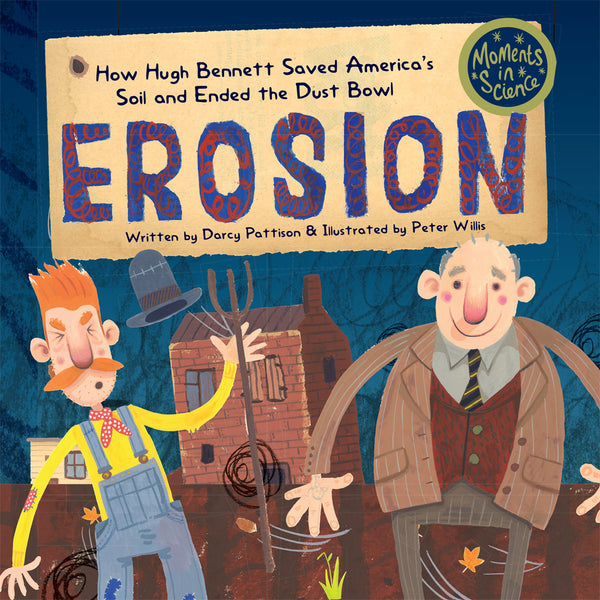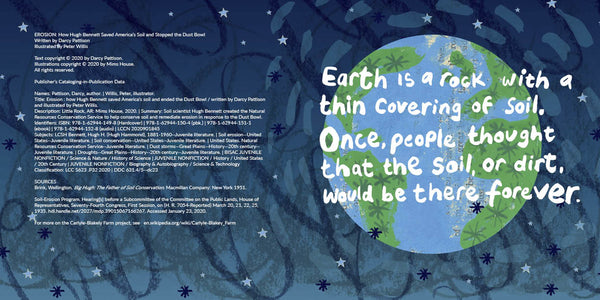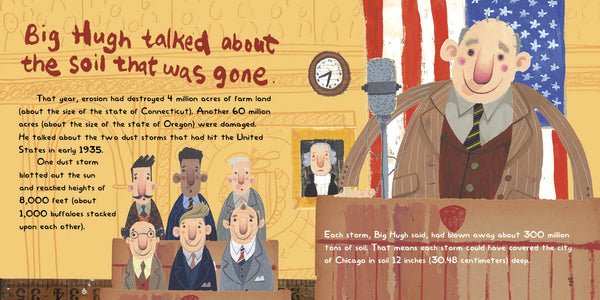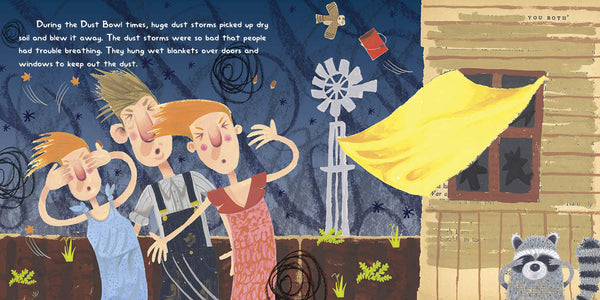



Shipping calculated at checkout
about the book
- by Darcy Pattison
- illustrated by Peter Willis
- 8.5" x 8.5"
- 32 pages
- 4th-5th grade reading level, 810L
Scientist Biography for Kids
How Hugh Bennett Saved America's Soil and Stopped the Dust Bowl
by Darcy Pattison
When the dust storms of the 1930s threatened to destroy U.S. farming and agriculture, Hugh Bennett knew what to do. For decades, he had studied the soils in every state, creating maps showing soil composition nationwide. He knew what should be grown in each area, and how to manage the land to conserve the soil. He knew what to do for weathering and erosion.
To do that, he needed the government’s help. But how do you convince politicians that the soil needs help?
Hugh Bennett knew what to do. He waited for the wind.
Who Was Hugh Bennett?
Born into a farm family, Hugh Bennett (April 15, 1881 - July 7, 1960) was always a farmer at heart. He became a soil scientist and traveled the United States mapping types of soil. When Congress created the Soil Conservation Service in 1935, he was the director. He and his team worked with farmers to stop the Dust Bowl. Within two years, the area affected by the Dust Bowl had been cut in half. Because of his work, soil conservation became a permanent national policy.
Important Facts About Hugh Bennett
- Hugh Bennett worked all his life to stop erosion, the washing away of soil by wind, water, and weather.
- Hugh Bennett studied soil erosion in the U.S., Panama, the Antilles, Honduras, Guatemala, and Cuba.
- In Cuba, Hugh Bennett wrote a book called Soils of Cuba. He helped sugar plantations to learn new ways of planting to prevent erosion.
- Hugh Bennett was fondly known by his friends as Big Hugh.
Kirkus Reviews: "A compelling, kid-friendly, and visually appealing erosion story."
2021 Notable Social Studies Trade Book
This is the exciting story of a soil scientist confronting politicians to encourage them to pass a law to protect the land, the soil. When the U.S. Congress passed a law establishing the Soil Conservation Service, it was the first government agency in the world dedicated to protecting the land, to protecting the Earth.
Reading this amazing story of an unchronicled early environmentalist, Hugh Bennett, the founder of the NRCS (Natural Resources Conservation Service).
"The kids enjoyed listening to the story...and especially liked the part at the end where the erosion created a canyon. We also liked the connections to real life events to make the topic 'real life' rather than just an idea from a book." Darcy Kuchel, Hinton Community School, Iowa
TEACHING RESOURCES
Watch this USDA video about Hugh Bennett, including historical footage.
MOMENTS IN SCIENCE SERIES - Read More
This eight-book series of nonfiction STEM books highlights biographies of scientists and moments when science changes in some way: a discovery, a new understanding, a new photo, or a Nobel prize award. Scientist's biographies combine with an historical event, and they are wrapped up in clear, concise, and fun explanations of scientific principles. Come and have fun reading an excellent nonfiction picture books.
This series has received a starred review, two NSTA Outstanding Science Trade Books, Junior Library Guild selection, NSSTA Notable Social Studies Book, and the Eureka! NonFiction Honor award (CA Reading Assn.). See the entire MOMENTS IN SCIENCE series here.


